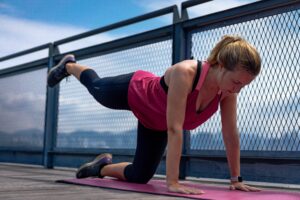We are getting warmer weather, and you know what that means – BIG SALADS! We can’t talk about salads without talking about salad dressing. If you want a healthy salad that achieves your goal of keeping your meal low-cal, you have to make modifications to what you find in the grocery store aisle. Otherwise, your dressing may be be more calories than the salad.
If you are like me, you don’t want just a measly drizzle – that’s not the point of dressing! Dressing shoudl bathe the chopped veggies and greens in a yummy, zingy, salty and sometimes sweet goodness. But not for 200 extra calories, saturated fat, and added sugar that won’t even cover the whole salad.
While we were in quarantine, I spent much time following and collecting salad dressing recipes. During this research I realized there were two fundamental tweaks I needed to make to meet the specs above:
- Make them simpler. We don’t have time to assemble a jillion ingredients.
- Make them more calorie-friendly. I want to be worried about dressing dribbling down my chin, not sabotaging my diet.
- Have some store-bought options on hand. Because sometimes we are on the go, really hungry and really in a hurry.

DIY salad dressings (30-35 calories or less per 2 tbsp serving)
I will list the ingredients for each, but the instructions are all exactly the same. Once you get them all in a bowl, whisk them together, then transfer to a blender, Nutribullet, or Ninja mixer and blend with desired amount of sea salt and black pepper. If you need something more quiet, you can whisk most of the ingredients together, or try one of the more quiet blenders.
You may want to play with the measurements to adjust to your desired level of thickness and consistency. DIY dressings (30 calories per serving)(last 3-4 days in refrigerator). If a dressing is too thick, add some water or extra vinegar to thin it out. If you want it sweeter, add some monk fruit or stevia. My favorite brand of natural no-calorie sweetener is Lankato Monk fruit sweetener.
Another suggestion to manage portion size: put the dressings in one of those spray bottles you can buy at the store. This will more evenly distribute the dressing and help you be less heavy handed. Or, buy a set of these dressing containers so you can pre-measure the amount of dressing for the salad to make sure you are not overdoing the serving size.
DIY Green Goddess – half an avocado, half a cup of Apple Cider vinegar, garlic clove, lemon juice
DIY Thousand Island- 4 tablespoons of light mayo, ½ a cup of red wine vinegar, shallots, and 2 tsp dijon mustard.
DIY Ranch – 1/2 a cup greek yogurt, basil, dill, 1/2 cut unsweetened plain almond milk
DIY Sesame Ginger – 1 tablespoon of sesame seeds, 1/4 cup rice vinegar, 1 tsp miso paste, 1 tsp powdered ginger (you can use fresh ginger, as well, or a paste variety).
DIY Miso Dressing – 1 tbsp miso paste, 1 tbsp coconut aminos or tamari sauce, lemon juice, 1/4 cup rice vinegar (coconut aminos and tamari are healthier soy sauce substitutes)
DIY Greek dressing- 2 tpsp olive tapenade OR 1/2 cup kalamata pitless olives, red wine vinegar, basil, lemon juice
Additional optional ingredients for all of the above:
- Garlic
- Shallots
- Carrots and celery (adds volume and a little sweetness)
- Sea salt and pepper
- Monk fruit powder to sweeten any of the above
Store bought salad dressings
- Bragg’s apple cider vinaigrette – with only 15 calories per 2 tablespoons, salt free and oil free, this dressing is so delicious you don’t miss any of it. Note that the labeling is easy to confuse with the regular Bragg’s vinaigrette, which still isn’t a bad deal at 80 calories a sebring. You can find this at most main chain grocery stores and on Amazon.
- Bragg’s ginger sesame dressing – this is pretty decent for most Asian salad dressing, with low sugar and 90 calories for two tablespoons. You can dilute it more by adding more vinegar once you have already used some.
- Makoto dressings: The best and most low-calorie line of Asian dressings, this comes in a ginger, honey, and wasabi flavor. It tastes like those yummy appetizer salad you get at Japanese restaurants, but for way less calories (70-80 per serving). These are mostly available in the refrigerated section at Artisanal grocery stores like Fresh Market. Unfortunately, it has to be refrigerated at all times, so it can be tough to order online, but the maker of the sauce has a very handy directory.
- Walden farms (variety of flavor) – First have to qualify that there are definitely mixed reviews on Walden Farms dressings They are advertised as having “zero” calories per serving, which basically food manufactures are permitted to do if a given serving is under 5 calories. For barely any calories a serving, they do a good job, especially their Bacon ranch flavor, in my opinion. Some people, howvever, do not like the aftertaste. You have to make the decision for yourself!
- Mantova Italian dressing spray – this is a basicl balsamic-olive oil spray. 1 spray is 10 calories, so be very light handed. Pretend it’s your hair, and you are using Aquanet (that 80s hair spray that makes your hair super crunchy if you use too much).
Finally, a caveat: Calorie Friendly does not mean CALORIE FREE. Any recommendation I make still means you should measure or at least eyeball the amount, and track your calories as I recommend in my post on the importance of metrics.






